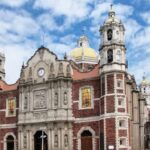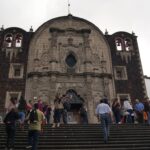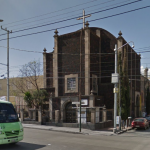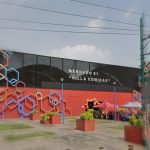
The Museum of the Basilica of Guadalupe is on the northwest corner of The Old Basílica de Guadalupe: The Cristo Rey Expiatory Temple. The partially separated building is the result of a wall collapse. The resulting repair work left room for the museum at the now partly separated wing of the building.
The museum is home to the world’s largest collection of art related to Our Lady of Guadalupe. The collection also includes a Novohispanic, European, and Asian art works ranging in dates from the 15th through the 20th centuries. Among these are important works by Matías de Arteaga y Alfaro and Cristóbal Villalpando.
The museum opened in 1941. Today the collection includes more than 4,000 objects. Included are paintings, sculptures, liturgical objects like chalices, missals, and ornate candle sticks. There are also examples of furniture from bygone abbots’ chambers. And all of these are distributed among twelve separate halls. Each is thematically organized around aspects of the Mexican Catholic and Marian traditions.
In one of the halls, the old sacristy of the original temple of Guadalupe is displayed. This one has been preserved from the time of the partial building collapse in the early 20th century. Another is dedicated to the Archangels, the figure of Saint Michael being heavily featured in numerous pictorial works.
The former Capuchin nuns’ convent, the building was built in the late 1700s. Having suffered structural instability due to the City’s soft soil, as well as numerous earthquakes, in 1976 control piles were added to the building’s foundations. This was nearly simultaneous with the building of the new Basilica Building.
Noteworthy is the Museum of the Basilica of Guadalupe entrance hall. Here the walls are covered with over 2,000 votive images. These pictorial votive offerings depict favors received. Petitioners have created the works themselves to show public gratitude to the Virgin of Guadalupe. It’s an immense collection of vernacular art dating predominantly from the 18th and 19th centuries.
 +52 (55) 5118 0500
+52 (55) 5118 0500
 https://virgendeguadalupe.org.mx/en/museo-de-la-basilica-de-guadalupe/#1565895708785-e2744481-a6e1
https://virgendeguadalupe.org.mx/en/museo-de-la-basilica-de-guadalupe/#1565895708785-e2744481-a6e1

Nearest at 0.06 kms.

Nearest at 0.08 kms.

Nearest at 0.09 kms.

A planned temple and sanctuary dedicated to the first saint indigenous to the Americas . . .

A fantastic place for eating just outside the basilica . . .

A very old church calls to mind the long history of the Villa Guadalupe Hidalgo . . .

A fantastic place for lunch just outside La Villa . . .